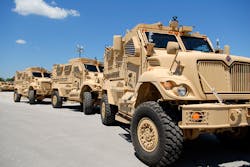I write a great deal in this space about behavior behind the wheel and the impact of distracted driving on highway safety, but sometimes interesting new angles appear in the debate surrounding such subjects.
For example: there’s an awful lot of research about how young, inexperienced drivers (read as: teenagers) suffer from higher-than-average crash risks. But here’s a population at a high risk of crashes we often don’t consider: military personnel returned from deployments in combat zones.
According to study entitled Returning Warriors conducted by insurance provider USAA, troops coming back from deployment had 13% more at-fault accidents within the first six months of returning when compared to the six months prior to deployment.
[As it’s also National Work Zone Awareness Week, I’m going to veer off for a moment on a tangent. The video below, dubbed The Close Call, is a stark reminder that what goes on while we’re on the road often circles back to impact us when we’re off it.]
The company’s research – conducted on private passenger vehicle driving experiences of USAA-member military personnel over a three-year period, which included 171,000 deployments to various overseas locations – also found that enlisted personnel are far more prone to such accidents than officers, with those in the Army and Marines suffering much higher crash rates than those in the Navy or Air Force.
Why, might you ask? Well, in research unrelated to USAA’s study, Professor Erica Stern of the University of Minnesota examined the driving experiences of returning soldiers and determined “carryover” driving behaviors that may help explain some of this increase.“Depending on their military assignment and time of deployment, troops may have driven slowly to be vigilant for explosives or attacks, or they may have driven very quickly to reduce their time at risk in transit,” she explained. “When they come home, they report problems speeding or being unable to drive on highways comfortably. Soldiers also had to keep their convoy intact, and therefore did not yield to people or traffic.”
In short, Professor Stern determined that military personnel develop what she calls “potentially lifesaving driving habits” during deployment, but these very same habits often put them in harm’s way when they are brought home.
Here are some examples of such behaviors behind the wheel: Reluctance to stop at intersections; driving at inappropriate speeds, either too fast or too slow; changing lanes while traveling under bridges; reluctance to use seat belts (in case of attack, you gotta get out fast and get shooting even faster), and driving in the center of roads.Here are some other factoids gleaned for USAA’s Returning Warriors study:
- Enlisted personnel (grades E1-E4) had 22% more at-fault accidents, noncommissioned officers (grades E5-E9) 10% percent more, with officers 3.5% more than the average civilian.
- Losing control of the vehicle was the most common cause of at-fault accidents.
- “Objects in the road” as the reported cause of accidents increased dramatically, more than any other cause.
- Younger (under 22) drivers’ crash rates were more than three times the crash rates for older drivers.
- Multiple deployments led to higher crash rates, and individuals with longer deployments were generally more likely to be involved in at-fault accidents.
Unfortunately, there’s no easy solution – something addressed bluntly by retired U.S. Army Maj. Gen. Kevin Bergner, who now serves as president of USAA Property and Casualty Insurance Group.
“Like other traffic safety issues that require behavioral changes, there are no easy solutions with this one,” Bergner said. “One thing we can all do, however, is encourage a dialogue about it.”
Now, let’s change focus a little bit and discuss distracted driving again but from a slightly different perspective: how such behavior can impact the bottom line, especially in terms of company liability.According to a new National Safety Council (NSC) white paper called Employer Liability and the Case for Comprehensive Cell Phone Policies, liability costs should be of great concern to companies large and smal.
That's because there have been many successfully prosecuted cases – with awards in the tens of millions – involving employee-owned cell phones and cars and in situations where employees were driving during non-working hours or engaged in personal phone calls, the group noted.
Indeed, the NSC estimates that at least 24% of crashes in 2010 involved drivers using cell phones, including 1.1 million crashes where drivers were talking on cell phones and a minimum of 160,000 crashes where drivers were texting. And the National Highway Traffic Safety Administration (NHTSA) and the Federal Motor Carrier Safety Administration (FMCSA) estimate on-the-job crashes cost employers more than $24,500 per property damage crash – with the costs rising to $150,000 per injury and to as much as $3.6 million per fatality.
“Employers should know a policy that prohibits handheld and hands-free cell phone use by all employees while driving is not only a best safety practice but also contributes to the bottom line,” stressed Janet Froetscher, NSC’s president and CEO.
“With the intense publicity surrounding cell phone distracted driving in recent years, it would be difficult for employers and employees to argue that they’re not aware of the dangers,” she warned. “Beyond the safety issues, employers are now being held to legal responsibility. Employers are responsible for ensuring their employees adhere to applicable federal agency regulations and federal, state and municipal laws.”
Just another safety perspective to consider as we pilot our vehicles upon the nation’s roads day in and day out.



